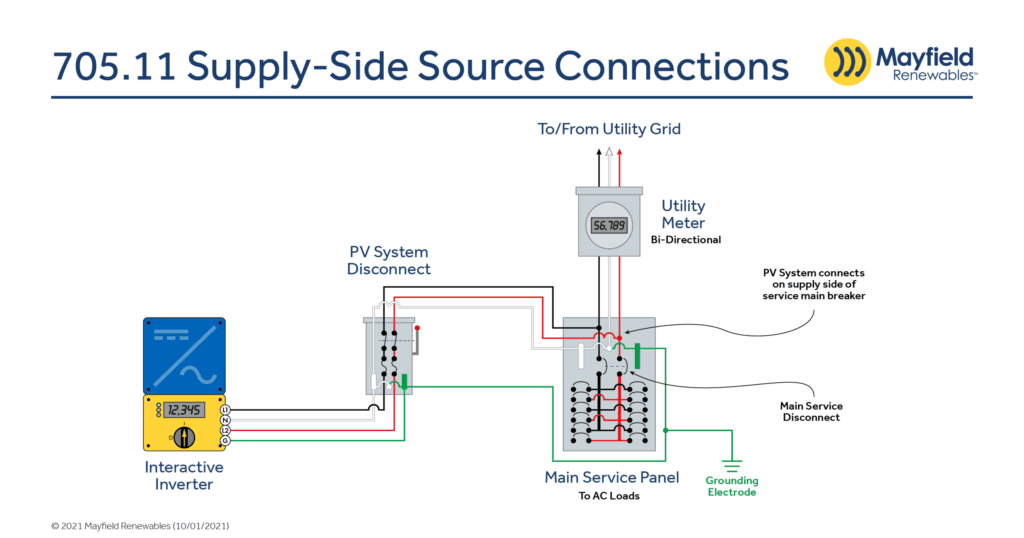Code Corner: 2020 NEC 705.11 Supply-Side Connections
In this edition of our Code Corner series, we’re covering 2020 NEC section 705.11 as it pertains to supply-side connections.
New to the NEC 2020 we have section 705.11 which helps us understand how to make supply-side connections more clearly than previous iterations. To this point, installers have been making supply-side connections in PV systems following the Code to the best of their ability. But with some admittedly vague rules around a few key issues, we wanted to address supply-side connections here.

One of the most commonly asked questions and sources of confusion is how to handle the connection between the neutral conductor and the grounding conductor. We were oh-so close to having very direct Code language included in Article 705 on this topic. But the Code making panel pulled the language at the 11th hour. Interestingly, the draft language is referenced anyway in the NEC 2020 Handbook explanatory material associated with the new section 250.25 and helps us understand the intent of the new language even though it didn’t make it into the 2020 Code cycle.
250.25, which simply directs us to the subset requirements of section 250.24 (A through D) is the best resource for installers to use when it comes to the topic of neutral to ground bonding requirements. These are not new requirements but nonetheless provide very helpful guidance. In the end, the most succinct advice for supply-side connections is to treat them as new service disconnects, even though as we’ll explain, PV systems do not constitute a new service.
To help illustrate common supply-side connection challenges, let’s look at an example schematic for a typical grid-tied PV system and use the Code language to answer a few common questions we hear from contractors and installers.

Do I have to run a neutral conductor to the PV system disconnect?
Yes, one point of clarification is that we’re now clearly required to bring in a neutral conductor from the main service entrance conductors into the PV system disconnect. Note that a neutral conductor is still required even if the inverter doesn’t require a neutral. This was often debated in the past but is now fully codified through section 250.24(C) for clarity moving forward.
Do I have to bond the neutral conductor and the grounding electrode conductor to the service equipment enclosure?
Yes, sections 250.24(B) and (D) both help us here. Section 250.24(B) requires that “an unspliced main bonding jumper shall be used to connect the EGC and the service disconnecting enclosure to the grounded conductor” and section 250.24(D) further clarifies that “a grounding electrode conductor be used to connect the equipment grounding conductors, the service equipment enclosures and the grounded service conductors” so there is no more ambiguity about if the ground and neutral needs to be bonded here in the enclosure.
Can I run the grounding electrode conductor through the same conduit as my current-carrying conductors or do I need to run it separately to the grounding electrode?
Unfortunately, this question is still debatable. For guidance, we look to section 250.64 (subsections A through F) to understand how we would make the connection of the grounding electrode conductor (GEC) to the grounding electrode (GE) that we’ve shown here for the different pathways for this connection. Section 250.64(A)-(F) is still not clear on what path to take with the GEC leaving the disconnect. Physically, it could be easier to run the GEC through the same conduit back to the main service and attach it to the grounding electrode system in the main service panel (not shown here), as long as we comply with 250.64(E), which requires us to bond the GEC at both ends of the raceways “to create an electrically parallel path.” This method seems to be supported by section 250.64(F)(1) stating that “the grounding electrode conductor shall be permitted to run to any convenient grounding electrode available.”
Alternatively, section 250.64(F)(2) states that “Grounding Electrode Conductors shall be permitted to be run to one or more grounding electrodes individually” as we have in our schematic above. As always, we recommend that you work with your AHJ to clarify what they prefer, given the variety of site characteristics we’ve seen and the ambiguity of the Code in this case.
Is a supply-side connection a new service?
No, another point of clarification is that this is not a new service according to the new definition of a service in Article 100. We also recommend taking a look at this section of the NEC 2020 Handbook for an even better description of service. However, note that NEC 230.82(6) stipulates that the supply-side connection must be “service rated” which could cause some confusion for the inspectors and installers.
If you have questions on how to ensure your systems designs comply with NEC section 705.11, our System Design & Engineering team is happy to help. Contact us to start a project or learn more. You can also find more of our Code Corner videos on the Mayfield Renewables YouTube channel.










